After the Sepik and the Highlands, I went to Lae and stayed there for a bit. Lae is PNG’s biggest port, second biggest city and from here I wanted to make it to the big islands to the east of the mainland. Since a bad ferry accident some years ago, ships are hardly used to transport passengers. I was asked 300 kina (less if you are student) for a four-day ferry ride to Rabaul that is once a week. Instead, for a bit more money I decided to fly to Kavieng, which is the main town on New Ireland and from there make it overland/water to Rabaul instead.

I flew to Kavieng on Airlines PNG which is certainly the cheapest airline in PNG. The flight was nice, we made a stopover in Rabaul and got some crackers and apple juice.

I flew to Kavieng from Lae (it was only 20 kina more expensive than only flying to Rabaul). Then I cycled down to Namatanai from where I took a boat to Rabaul.
This is a GPX file for exploring in Google Earth.
In Kavieng I was going to couchsurf with Helen, but instead stayed with her friend Brendan. They both work for Air Niugini and thought I had committed an unforgivable sin by arriving on the competition’s aircraft but soon forgave me. Both took great care of me. Kavieng is a nice and friendly town. There are more Chinese-run supermarkets per capita than anywhere else in the world, I guess. The market is quite nice but generally Kavieng does not have too many sights. I spent my time meeting Brendan’s friends and trying to find a bicycle that would take me down to the other end of New Ireland.

One day we went to Nusa Island which is just off Kavieng’s coast. There is a nice surfer’s resort there where we had a drink. Later I learnt it cost 400 kina (160-170 USD) a night (cold shower and pit toilet included). Welcome to PNG!
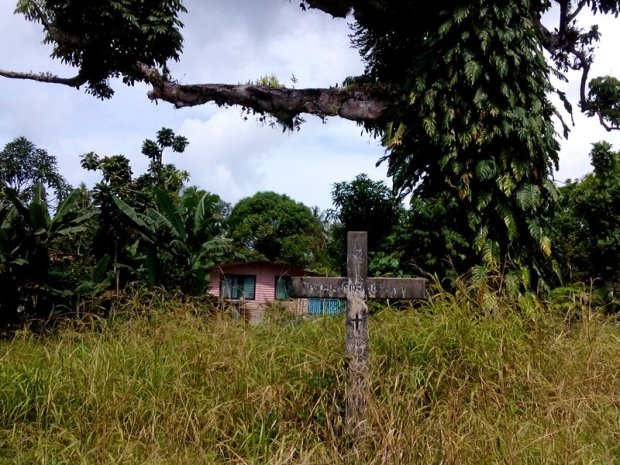
One of the few sights of Kavieng is the grave of a German guy whose name was Boluminski. He was ruling over the island during the German years of PNG and he is famous for building a road on the east coast of the island. Well, he didn’t really build it – he asked each village to build and maintain a stretch of the road. When he traveled on the road and he thought some parts were not in good enough condition, he asked the respective villagers to carry him and his stuff over the bad stretches of road. The Boluminski highway is 265 km long – from Kavieng to a place called Namatanai and I was to find out it was one of the best maintained roads I saw in all of PNG. I wanted to cycle the length of it.
Finding a bike was not easy. Some places listed in the Lonely Planet either didn’t have bikes or wanted too much money. Finally I found a guesthouse owned by a guy named John Knox, who was renting bikes to 60 kina a day. He was not very helpful and a bit indifferent. Maybe he’s OK but I’ve just been spoilt by the rest of my experiences in PNG where most people will go out of their way to help the foreign traveler. I guess that being involved in tourism (he has a guesthouse and provides transport services), John might have witnessed enough white man disgrace to leave him without a soft spot for the odd innocent Bulgarian traveler. Or, he had learnt too well from white men to be a businessman.
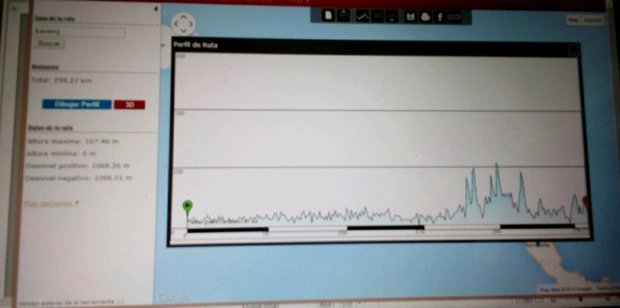
I started on a Friday and had three days to complete the journey – 90 km per day.
Perfilderuta.es is an excellent website that shows how much ups and downs to expect.
On day one I started late because John had not really prepared my bike properly and some time was spent trying to fix it. He finally just gave me a “new one out the box”. It did come out of a box but it was certainly not brand new. It was a good bike anyway with a rack for my backpack.

I rode for most of the first 35 km with these three boys who were training for the Independence day bicycle race that was going to be held in four days’ time. They ride 70 km (from their village to Kavieng and back) every morning, starting at 6 am. And then have a shorter session in the evening. The stakes are high – besides the money award, the first ten at the finish line will go to Port Moresby for another bike race. And the best cyclists from there will represent PNG internationally. They didn’t have very good bikes – basically as good as they could afford, one even borrows his from the neighbors every day for training and will also use it for the race, but they were very eager to win. Back at their village we had a chat on the beach, they gave me some coconut to drink and some yasin – a red fruit that grows on a tree, has the shape of a flower and tastes like strawberry.
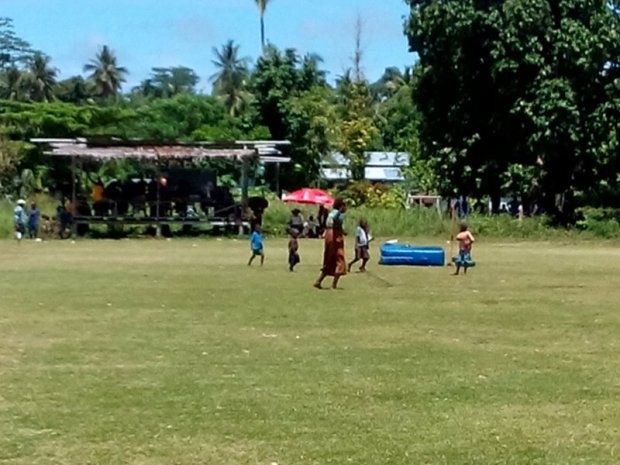
Into the afternoon the ride became very sweaty, it was boiling hot. I was looking for an interesting place to stop for rest and there came the odd New Irish school sports competition. I stayed for a while and watched the local cheerleader – reportedly she is “a bit of a clown”.

Then there was a lot of apinuning (good afternoon) – everybody greeted me. When I entered a new language zone (I passed three that day) I’d learn how to greet in the local language, which always produced a lot of laughs. These folks were so delighted that they asked me to stop and invited me for… a smoke.
The day ended at Cathy’s place in Laraibina where people come to see the huge eels that live in the stream next to her house. Cathy is a veteran flight attendant with Air Niugini. She flew “back in the old days when flying was an interesting experience”. She’s quite an interesting character. Most societies on New Ireland are apparently matriarchal (daughters inherit the property and their husbands move in with them, women decide on important matters and usually run any business) and Cathy is certainly a good example. She can accommodate people for the night, but ask the price first!

The eels are very special to Cathy who’s having hip problems and it takes a lot of effort for her to evacuate when they have the occasional tsunami warning. Back in 2008 they had very high tides for a few months when their homes got flooded and people had to camp out in the bush. A few days before the first time the high tide came, the eels escaped upstream, obviously fleeing the coming tide that they could sense. Now Cathy says she would not evacuate when there’s a tsunami warning, unless the eels would evacuate first. Anyway, I hope no tsunamis are going to hit any time soon, not only for her sake.
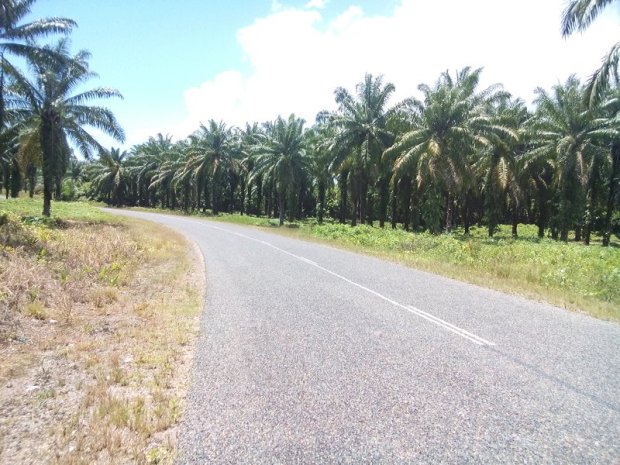
The second day I remember mostly a lot of oil palm plantations. The terrain was also not as flat as the first day but the occasional hill was not too bad either. Doing my 90 km that day was not so difficult even if I had to spend two hours waiting out a rain shower around noon.
I passed through a village called Libba, which is famous for the carving and mask-making tradition of the Malagan people. The local church had really nicely carved pillars.
That night I ended up staying at a Seventh Day Adventist guesthouse in Dalom that was a very nice place with a turqoise stream flowing into the sea and some nice hills behind. The place was well run and apparently there is good snorkelling and hiking. It was only 80 kina a night and I got to pitch my tent in the dining room for half price.

The road passes many rivers and streams, all of them bridged. Some had nice, clean, turquoise water, others were quite murky, but very nice, overgrown with jungle (and probably croc infested).
Some more views of and from the road:



I have to say New Ireland had some pretty interesting traditional architecture. Most bamboo houses had very sophisticated roofs and consisted of different rooms and compartments.
The third day I started early because I wanted to make sure I’d make it on time to Namatanai even if there would be rain. And then I knew that there would be about 50 km of unsealed road that day. That part is in fact compressed crushed white coral and actually quite comfortable to ride unless there were many potholes. It was bad in some places but not too bad. And a good section of it was being prepared for sealing so it was actually quite comfortable.
From Namatanai there is a well organized truck+banana boat option to Kokopo/Rabaul. The better company, Solwara Meri (means mermaid in Tok Pisin – solwara “saltwater” + meri “lady”) is probably the only business in PNG that runs on time. They left exactly at 6 am and made it to Kokopo by 10 am as promised. They also have a guesthouse for “only” 150 or 250 kina a night but I stayed in a room with the other passengers waiting for the morning passage that was free.
I will leave Kokopo and Rabaul for another post. I have a feeling that I am making these posts too long and nobody reads them…:/
PRACTICAL INFORMATION
At the moment there seem to be three main commercial airlines in PNG. Air Nuigini has the best service and safety record but can be very expensive. Airlines PNG has had some incidents in the past but people say it’s getting better and I found them to be the cheapest. Travel air is a newcomer (who knows how long they are going to last), use old planes but are worth checking out. The problem is you can’t buy your ticket online, only in their offices. You can view prices online but it turns out they are not the correct ones. They have phone numbers.
In Namatanai there are apparently a couple of places with cheap accommodation. Check out Wikitravel.











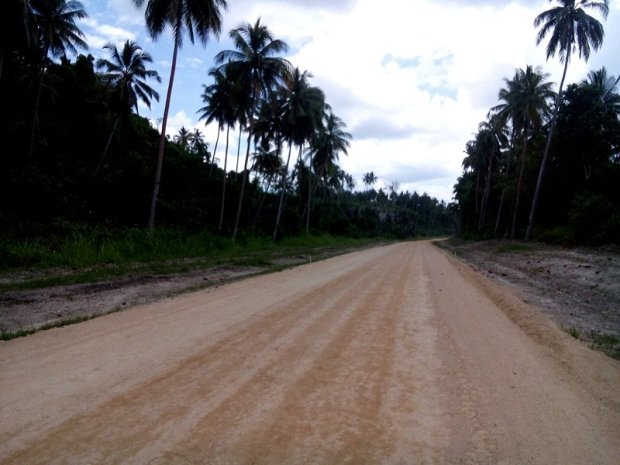



Tishenze….cheta ti vsichkite postove s ogromen interes…kolkoto po-dulgi…tolkova po-dobre….:)
Мерси Мартичка, ще пиша колкото мога повече тогава. Другите после на теб да се сърдят 😝